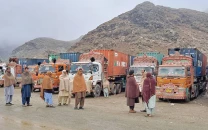No safety net: ‘Most people accept whatever work comes their way’
WB economist says measuring unemployment in South Asia irrelevant as growth in workforce, employment remains the same.

In South Asia, measuring unemployment is irrelevant as most people entering the labour market find some kind of job due to absence of a safety net but a lot of these jobs are not up to the mark, says Dr Kalpana Kochhar, the World Bank’s Chief Economist for the region.
In an interview to The Express Tribune, Kochhar said “measuring unemployment is not meaningful in South Asia” as this has resulted in a situation where growth in labour force and employment generation is almost the same.
According to the Labour Force Survey, the unemployment rate in Pakistan is 5.9 per cent. However, a recent WB study titled “More and Better Jobs” reveals that during the last decade (2001-2010) the growth in labour force was 3.6 per cent while the growth in employment generation too remained at 3.6 per cent. Half of the jobs were low paid and based on self-employment while regular employees were slightly over one-fifth.
“Because there is no safety net and no way to protect unemployed people, so people get self-employed but the quality of employment is not good,” said Kochhar.
According to the WB study, Pakistan has the highest rate of jobs growth in South Asia. Explaining the findings of the study, Kochhar said even the WB wondered how that could happen when the country had an average economic growth of three per cent.
“We diagnosed that most of these jobs were created in the first half of the decade (2001-2010) when Pakistan was growing faster and then slowed down in the second half.”
She said South Asian countries need to educate people and impart skills that can easily be translated into employment. The countries will gain a lot from integrating within the region.
Kochhar said Sri Lanka was already becoming aged while Afghanistan and Pakistan have a very young population. There is a lot of space for sharing production and maximising job creation within the region.
However, she said the biggest obstacle in creating jobs is the energy crisis and South Asian countries must overcome this for creating an average 1.5 million jobs per month.
According to the study, about 850,000 jobs were created every month in the last decade. But the challenge going forward is not simple.
“If female labour participation is going to rise, the region needs to create at least 1.2 to 1.5 million jobs a month. There is no doubt that the future is going to be considerably more challenging,” she said.
Though the biggest constraint in creating jobs is electricity, unskilled labour and governance remain two other important constraints, said the chief economist, adding the governance has to do with accountability, transparency and policies that minimise the scope of corruption.
She said the findings show that the main driving force for bribery is getting a electricity connection. “You need to have transparency and accountability and need to have systems to ensure that the supplier of services is transparent and accountable.”
Kochhar said real wage growth in the region was much slower and the governments should create facilitating environment for firms to grow. The people who join these firms should be more productive and that will result in higher output and higher labour share.
Kochhar argue that in conflict-stricken areas the public sector has to take a leading role. Jobs in these areas tend to be more rural in nature and generally low paying, therefore, these people remain more vulnerable. Typically, these people are less educated. In those areas, there is a greater role for public sector to provide jobs but not on a permanent basis.
Published in The Express Tribune, January 17th, 2012.



















COMMENTS
Comments are moderated and generally will be posted if they are on-topic and not abusive.
For more information, please see our Comments FAQ